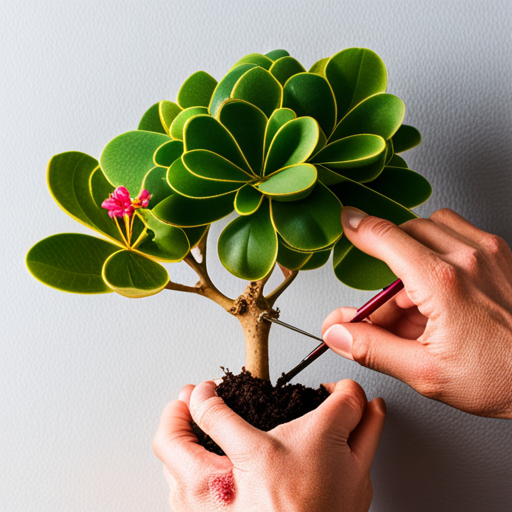Bamboo has the potential to thrive in desert conditions with careful selection of the appropriate species and proper care. In this regard, Desert roses are popular. They are scientifically known as Adeniums and are popular succulent plants that can be propagated through various methods, including cuttings and seeds. This article aims to provide a comprehensive guide on how to propagate desert roses, focusing on the different techniques and care tips for successful propagation.
When propagating from cuttings, it is advisable to select healthy and mature plants that are at least 2 years old. A 6-8 inch stem with several leaves should be chosen, and the lower leaves should be removed, leaving 2 or 3 at the top. The cutting should then be placed in well-draining cactus mix or sand and lightly watered. It is crucial to maintain the soil moist but not soggy until roots form, after which watering should be reduced.
Alternatively, propagation can be done by taking a 6-inch cutting, cutting it below a leaf node, and applying rooting hormone to the cut end. The cutting should then be planted in well-draining soil and kept in a warm and bright location. New growth is expected to appear within 4-6 weeks.
Furthermore, desert roses can also be propagated from seeds. Soaking the seeds in water for 24 hours before sowing them in well-draining potting mix is recommended. Once the seedlings have germinated, they can be transplanted into individual pots.
To ensure successful propagation, it is essential to provide desert roses with adequate sunlight, well-drained soil, and regular watering. Following these guidelines will enable enthusiasts to propagate and cultivate these beautiful plants effectively.
Contents
- 1 Our Highlighted Points
- 2 Methods for Propagation
- 3 Care Tips and Guidelines
- 4 Additional Information
- 5 Can Desert Rose Plants Be Used for Construction or Privacy Purposes?
- 6 Frequently Asked Questions
- 6.1 Can desert roses be propagated through division?
- 6.2 How long does it take for desert rose cuttings to root?
- 6.3 What is the best time of year to propagate desert roses?
- 6.4 Can desert roses be propagated from leaf cuttings?
- 6.5 Do desert roses require a specific type of fertilizer during propagation?
Our Highlighted Points
- Choose healthy, mature plants at least 2 years old for cuttings.
- Use well-draining cactus mix or sand for rooting the cuttings.
- Water lightly and keep the soil moist but not soggy until roots form.
– Provide plenty of sunlight and well-drained soil for general care.
Methods for Propagation

There are several methods for propagating desert rose plants, including using cuttings or seeds, which can both lead to the development of new plants.
When using cuttings, it is important to select a healthy mother plant with strong, woody stems. Cuttings should be at least 6 inches long and have the lower leaves removed to prevent rotting. Using rooting hormone can be beneficial for encouraging root development in cuttings. After dipping the cut end in rooting hormone, the cutting can be planted in moist potting mix and monitored for moisture levels.
On the other hand, desert rose propagation from seeds involves soaking the seeds in water before sowing them in well-draining potting mix. It is essential to keep the soil moist but not wet and wait for germination. Once the seedlings have sprouted, they can be transplanted into individual pots with well-draining potting mix and provided with appropriate moisture levels for new growth.
Here is a comprehensive guide on how to transplant bamboo effectively.
Care Tips and Guidelines

To ensure successful propagation, it is important to provide ample sunlight and well-drained soil for the plant. Desert roses thrive in bright, sunny locations, so it is crucial to place them in an area that receives at least six hours of direct sunlight per day.
Additionally, well-drained soil is essential to prevent root rot and ensure the health of the plant.
Watering requirements for desert roses include deep watering once a week during the growing season. This allows the roots to receive adequate moisture without becoming waterlogged.
During the winter months, when the plant is dormant, it is important to reduce watering and allow the soil to dry out slightly between waterings.
By following these care tips and guidelines, desert rose propagation can be successful and result in healthy, thriving plants.
Additional Information

Indoor and outdoor spaces can be enhanced with the addition of these plants, which thrive in areas with hot summers and cold winters.
Desert roses, also known as Adenium obesum, make a great addition to both indoor and outdoor environments. These plants are well-suited for indoor growth in regions with extreme temperatures, as they can tolerate hot summers and cold winters. When grown indoors, they should be placed near a sunny window to receive ample sunlight.
Outdoor growth is also favorable for desert roses, as they can flourish in well-drained soil and under direct sunlight. Apart from their aesthetic appeal, desert roses offer several benefits. They are known for their striking flowers and interesting, swollen trunk. Additionally, these plants require minimal care and can thrive in low-water conditions, making them a suitable choice for those with busy lifestyles or limited access to water.
Can Desert Rose Plants Be Used for Construction or Privacy Purposes?
Desert rose plants may not be suitable for construction or privacy purposes, but versatile uses of bamboos make them an excellent choice. Bamboo is strong, flexible, and eco-friendly, making it perfect for building structures or creating privacy screens. Its versatility makes it a top choice for various construction and privacy needs.
Frequently Asked Questions
Can desert roses be propagated through division?
Desert roses cannot be propagated through division. Instead, they can be propagated through cuttings or seeds. These propagation techniques offer benefits such as creating new plants and allowing for the expansion of a desert rose collection.
How long does it take for desert rose cuttings to root?
Propagation methods for desert rose include taking cuttings and using seeds. The time it takes for desert rose cuttings to root is typically around 4-6 weeks. Common mistakes during propagation include overwatering and not providing enough sunlight.
What is the best time of year to propagate desert roses?
The best time of year to propagate desert roses is in the spring, when the plant is actively growing. The best propagation technique is to take stem cuttings and ensure that the cuttings are placed in well-draining soil and kept in a warm, bright location. Common mistakes to avoid during propagation include overwatering and placing the cuttings in direct sunlight.
Can desert roses be propagated from leaf cuttings?
Leaf propagation of desert roses has a low success rate. Alternative methods such as stem cuttings and seed propagation are more commonly used. Stem cuttings have a higher success rate and can be done using healthy, mature plants.
Do desert roses require a specific type of fertilizer during propagation?
Desert roses do not require a specific type of fertilizer during propagation. However, it is generally recommended to use a balanced fertilizer with a ratio such as 10-10-10 to provide essential nutrients for healthy growth. The best techniques for desert rose propagation include using healthy mother plants, sharp knives, clean potting mix, and providing bright indirect light. Additionally, using rooting hormone can help promote successful root development in cuttings.

